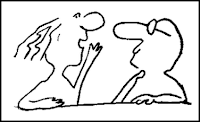EFFECTIVE LISTENING 1.1
"We were
given two ears but only one mouth, because listening is twice as hard as
talking."
There
is a real distinction between merely hearing
the words and really listening
for the message. When we listen effectively we understand what
the person is thinking and/or feeling from the other person’s own perspective.
It is as if we were standing in the other person’s shoes, seeing through
his/her eyes and listening through the person's ears. Our own viewpoint may be
different and we may not necessarily agree with the person, but as we listen,
we understand from the other's perspective. To listen effectively, we must be
actively involved in the communication process, and not just listening passively.
In Passive Listening we are genuinely interested in
hearing and passively listen. We assume that we heard and understand correctly
but stay passive and do not verify it. Passive listening is not
much different from hearing. For instance, many of us have found ourselves in
situations where our minds would drift, we would lose our motivation in
listening, and consider the information we hear as "a background
noise" or pretend that we're listening just "to be polite." We think that
we are listening, but in fact we are simply letting this
information go past our brain.
Active Listening is the single most useful and
important listening skill. In active listening we are also genuinely interested in understanding
what the other person is thinking, feeling, wanting or what the message means,
and we are active in checking out our understanding before we respond with our
own new message. We restate or paraphrase our understanding of their message
and reflect it back to the sender for verification. This verification or
feedback process is what distinguishes active listening and makes it effective.
Active listening implies listening with a purpose. We
might listen to gain information from the speaker, not just to
"fill in the awkward silence." When listening actively, we obtain
directions, pay attention to details, solve problems, get to know people, share
interests, feelings, emotions, etc. In active listening we engage ourselves
into the message that we hear, interact with it, pay attention to
sounds, expressions, intonation, as well as take note of what
we do not understand.
EXAMPLE: Passive listening is mechanical and effortless. It does not
require any special effort. You hear what your teacher says and you might be
able to tell the difference between major and minor points of the lecture, but
that is about it. Lack of enthusiasm and a "careless" attitude during
class characterize a student who is a passive listener. Active listeners, on
the other hand, really concentrate on the content of the lecture and not on the
lecturer or any random distractions in the room or their mind. They do more
than focus on facts, figures, and ideas and actively associate the material
presented with their own experiences. The content heard at every lecture is
converted to something useful and meaningful for the student. You must pay
special attention in class because, unlike when reading a textbook, you only
get one chance to hear and understand the information presented to you.
note: People speak at
100 to 175 words per minute (WPM), but they can listen intelligently at 600 to
800 WPM. Since only a part of our mind is paying attention, it is easy to go
into mind drift — thinking about other things while
listening to someone. The cure for this is active
listening — which involves
listening with a purpose. It may be to gain information,
obtain directions, understand others, solve problems, share interest, see how
another person feels, show support, etc. It requires that the listener attends
to the words and the feelings of the sender for understanding. It takes the same amount or more
energy than speaking. It
requires the receiver to hear the various messages, understand the meaning, and
then verify the meaning by offering feedback.
[to be continued...]






No comments:
Post a Comment